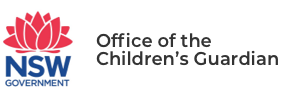General changes to the Children's Guardian Act 2019
The Children's Guardian Act 2019 came into force on 1 March 2020. Powers and functions of the Children's Guardian from the Children and Young Persons (Care and Protection) Act 1998 and Adoption Act 2000 were consolidated into the new Act. Regulations under these Acts will remain in force until new Regulations are made under the new Act.
Consolidating existing and new functions of the Children’s Guardian
Previous position
The Children’s Guardian’s adoptions functions under the Adoption Act 2000, her children’s employment functions and responsibilities regarding accreditation, monitoring and registration of out of home care are scattered through the Children and Young Persons (Care and Protection) Act 1998 are set out in s 181 of the Care Act.
The Children’s Guardian also has functions under the Child Protection (Working with Children) Act 2012.
Rationale for change
The consolidation of the Adoption Act and Care Act functions and responsibilities in one Act together with the expanded functions (i.e. in gaining responsibility over the Reportable Conduct Scheme and Official Community Visitors, both previously administered by the NSW Ombudsman and the new function to establish and maintain a register of residential care workers in out of home care) means that the Children’s Guardian’s functions would be to locate in a single place.
Impact after 1 March 2020
The functions in the Children’s Guardian will be located in a single piece of legislation – the Children’s Guardian Act 2019.
The Children’s Guardian will be responsible for administering the reportable conduct scheme and the community visitors scheme (transferred from the NSW Ombudsman)
The legislative lever to establish and maintain a register for residential care workers in out of home care - this is anticipated to be operational later in 2020 after further consultation. When operational, it will provide a mechanism for out of home care residential care providers to exchange information about the safety and suitability of residential care workers, prior to making a decision whether to engage a person.
The Children’s Guardian will continue to exercise functions under the Child Protection (Working with Children) Act 2012.
A new objects clause, paramountcy principle and guiding principles
Previous position
With no specific Act governing the Children’s Guardian’s functions, the objects and principles pertaining specifically to the Children’s Guardian’s role are currently non-existent.
Rationale for change
The objects and principles inform and reinforce the purpose of the legislation, which is to protect children by promoting and regulating the quality of organisations and people providing services to children.
An understanding of this overall object assists in clarifying how the various functions of the Children’s Guardian complement and work together as it is at the core of the Children’s Guardian’s work and the entire legislation.
The guiding principles are necessary in undertaking decision making under the Act.
Impact from 1 March 2020
There will be greater clarity about the object of the Act and how the various functions give effect to the overall object.
The Act makes clear that the paramount consideration in administering, operating and making decisions under the Act is the safety, welfare and wellbeing of children, including protecting children from child abuse – mirroring the Child Protection (Working with Children) Act 2012.
The guiding principles clarify what matters should be taken into account in administering the Act.
Independence and governance matters
Previous position
The process for appointment, vacancy and removal from the office of the Children’s Guardian is currently in the Care Act.
Rationale for change
The removal of office of the Children’s Guardian will draw on elements from the Ombudsman Act 1974 with the Children’s Guardian now being removed from office by the Governor upon the address of both Houses of Parliament.
With the expanded functions, the Children’s Guardian also needs to be able to appoint one or more statutory offices. Further, while the Children’s Guardian is an independent statutory office, given the transfer of the reportable conduct scheme, the legislation reiterates the independence of this role.
Impact after 1 March 2020
The Children’s Guardian can appoint statutory offices and her independence is enshrined in the legislation.
Information exchange to complement expanded regulatory role
Previous position
The Secretary of the Department of Communities can exchange information with a relevant body under s 248 of the Care Act.
Rationale for change
Noting the expanded regulatory role that the Children’s Guardian will now have, the information exchange provision that currently applies to the Secretary has been replicated so that the Children’s Guardian can share information with a relevant body (which includes prescribed bodies under the Care Act framework).
A discrete expansion of the Children’s Guardian’s existing information exchange powers at section 186A of the Care Act enables the Children’s Guardian to share information with the police and other investigative agencies including interstate and Commonwealth police and investigative agencies.
Impact from 1 March 2020
This replication will enable information of concern to be provided to entities on the same basis as the Secretary.
The capacity to share information with the Commonwealth recognises the new regulatory environment with the commencement of the Commonwealth NDIS Quality and Safeguarding Commission.
Increased reporting requirements
Previous position
The Children’s Guardian reports to the Joint Parliamentary Committee in relation to the administration of the Working with Children Check and the Ombudsman similarly reports in relation to the reportable conduct scheme.
Rationale for change
To ensure accountability and transparency in processes and decision making, the Children’s Guardian will report to the Joint Parliamentary Committee in relation to the administration of the reportable conduct scheme.
In addition, the Children’s Guardian is required to report to the Committee about policies and processes being adopted in relation to the exercise of her functions in relation to reportable conduct.
As well, there are a number of additional matters to be reported in the Annual Report in relation to the new functions.
Impact from 1 March 2020
The additional reporting requirements will ensure greater scrutiny, transparency and accountability in processes and decision making.
